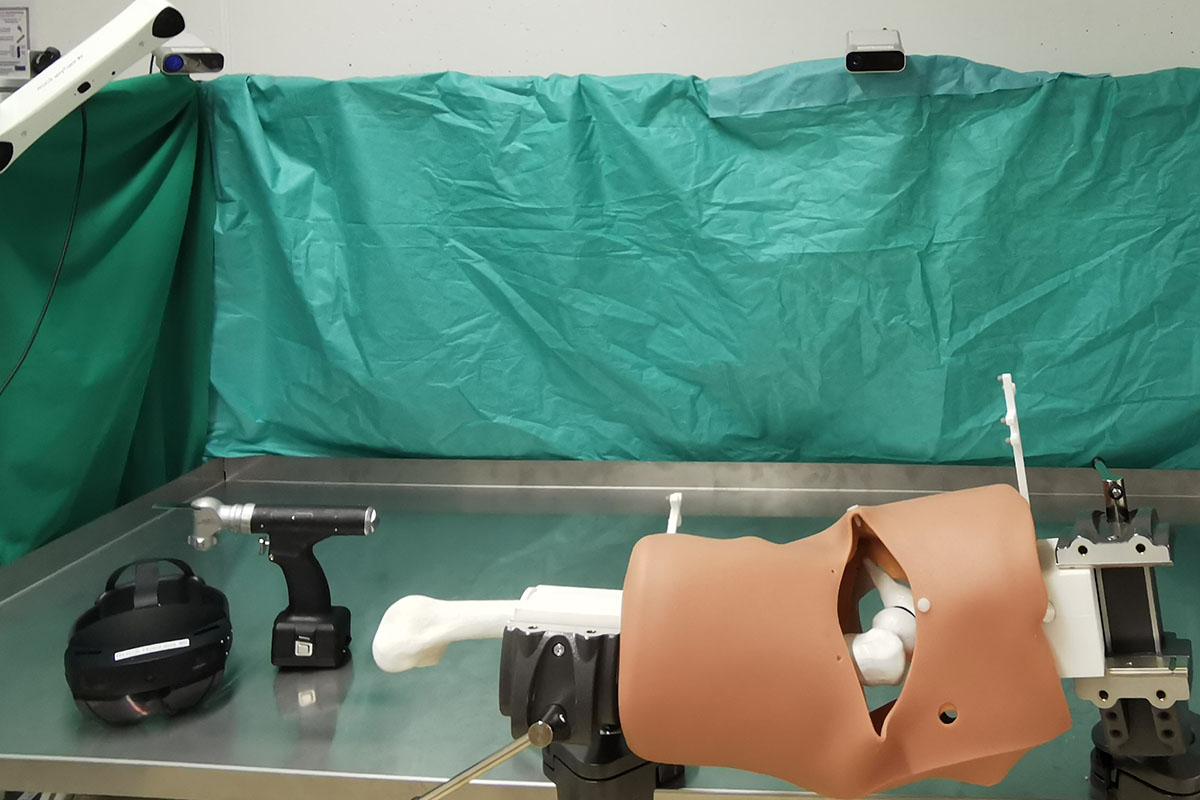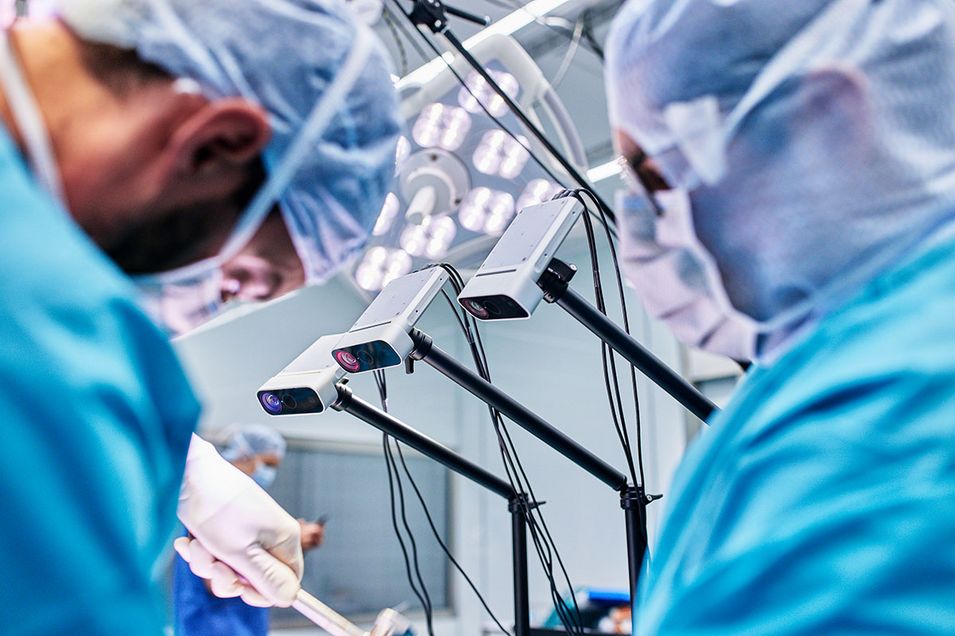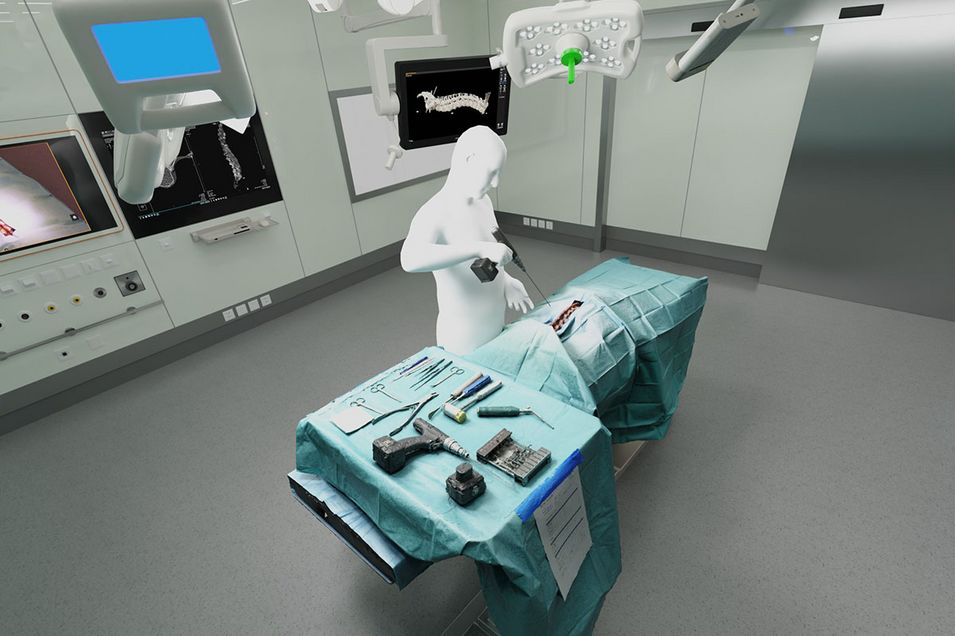Research in Orthopedics
Advancing Surgical Training and Education Through Technology
The traditional training approach of medical professionals, following the principle of ”see one, do one, and teach one“, is no longer aligned with contemporary requirements and the technological possibilities available for the education of surgical residents.
In the Innosuisse-funded project PROFICIENCY, Balgrist University Hospital is working together with two clinical partners and is receiving support from the Swiss Surgical Societies to develop and incorporate advanced surgical training programs, alongside simulation tools. In collaboration with ETHZ and ZHAW, implementation partners are creating advanced training tools, ranging from augmented reality-enabled (AR) open surgery training to immersive visualizations for medical education.
AR-Enabled Simulator for Total Hip Arthroplasty
This initiative aims to elevate open surgery training beyond the traditional human specimen-based gold standard. Our solution seamlessly combines sawbone- and human specimen-based training with simulation through augmented reality. This results in the benefit of realistic anatomical visualization while saving both resources and time. This integrated solution, embedded in a didactic training concept, comprises three essential components: the physical training setup, the AR-based guidance/instruction module, and the performance evaluation module. The training setup, as shown in Figure 1, includes the AR glasses, sawbone/human specimen anatomy, surgical instruments, and prosthetic implants. This unique combination allows the haptic sensation and computer-generated information can be used to visualize soft tissue and possible surgical complications.
A second pivotal feature is the training guidance provided by the AR application, which is used alongside the integrated performance evaluation. The trainee is AR-guided through the relevant steps of the intervention, while artificial intelligence (AI) is automatically identifying the different steps of the surgery. The level of support varies based on the skill level, ranging up to full navigation-like guidance, where for instance the exact position of a cut is displayed on the bone. Following training, performance is assessed automatically by evaluating surgical accuracy based on implant position, alongside tool, hand, and eye tracking data. This holistic approach aims to redefine open surgery training by seamlessly blending the advantages of cadaver-based realism with the technological precision of augmented reality.
Innovative Visualization
This focus aims to enhance the surgical training curriculum by integrating advanced visualization tools and learning materials. Moving beyond traditional teaching aids such as 2D illustrations and video recordings of surgical procedures, the initiative aims to develop photorealistic 3D reconstructions of critical surgical steps and detailed visualizations of essential anatomical structures. This enables surgeons to participate in a surgery virtually and to experience crucial steps in 3D. To realize this vision, we are establishing a comprehensive pipeline for data capture, processing, and visualization. This effort is the result of a collaborative partnership among Balgrist University Hospital, ETH Zurich, ZHAW, and Microsoft.
First, utilizing the state-of-the-art OR-X facility, we are setting up an experimental multi-camera system (Fig. 2) designed to efficiently document surgical operations. This phase involves identifying the optimal hardware and configuration settings to achieve superior visualization quality with minimal disruption to the surgical workflow. Importantly, this capture system is designed with the capability for deployment in actual operating rooms. Following the capture phase, the recorded data undergoes processing with cutting-edge deep learning techniques to produce photorealistic 3D reconstructions of the surgical scenes (Fig. 3). These reconstructions support interactive user engagement, offering novel opportunities for enhancing spatial understanding of surgical procedures. This research segment, led by ETH Zurich, focuses on advancing and customizing generalpurpose 3D reconstruction and tracking for operating room settings.
In the final phase, the effectiveness of the innovative educational approach will be assessed by means of a user study conducted with surgical residents at Balgrist University Hospital.



Förderung chirurgischer Aus- und Weiterbildung mithilfe innovativer Technologien
Der traditionelle Ausbildungsansatz der Medizin nach dem Prinzip von «See one, do one, and teach one» entspricht nicht mehr länger den heutigen Anforderungen und den technologischen Möglichkeiten. Das von Innosuisse finanzierte Projekt PROFICIENCY hat sich zum Ziel gesetzt, mit innovativen Ansätzen die chirurgische Aus- und Weiterbildung weiterzuentwickeln. Die Universitätsklinik Balgrist partizipiert daran primär mit zwei Unterprojekten im Bereich orthopädische Chirurgie: Zum einen liegt der Fokus auf der Entwicklung eines auf Augmented Reality (AR) basierten Simulators zum Training von orthopädischen Operationen wie Prothetik. Dabei wird die auszubildende Person mithilfe von AR durch die relevanten Schritte eines Eingriffs geführt. Diese Unterstützung reicht je nach Ausbildungsstand bis zur vollständigen navigationsähnlichen Anleitung. Nach dem Training wird die Leistung automatisch bewertet, indem die chirurgische Genauigkeit anhand gesammelter Daten ausgewertet wird. Zum anderen sollen fortschrittliche Visualisierungswerkzeuge und Lernmaterialien entwickelt werden, um einen Shift von 2D-Illustrationen zu fotorealistischen 3D-Rekonstruktionen zu vollziehen. Hierfür werden chirurgische Szenen mit komplexen, hochauflösenden Kameras im Simulations-Operationssaal OR-X aufgenommen und anschliessend mittels künstlicher Intelligenz zu 3D-Rekonstruktionen verarbeitet. Dies erlaubt, dass Chirurginnen und Chirurgen virtuell an Operationen teilnehmen und dabei wichtige Teilschritte in 3D erleben können.
At a Glance
Innosuisse Flagship Project PROFICIENCY
Key Collaborators
Subproject lead: Prof. Dr. Philipp Fürnstahl, Prof. Dr. med. Mazda Farshad, MPH, Prof. Dr. med. Patrick Zingg
Dr. Matthias Seibold
Prof. Dr. Siyu Tang
Dr. Sergey Prokudin
Prof. Dr. Helmut Grabner
Departments and Partners
Balgrist University Hospital, ROCS
Balgrist University Hospital, Dept. of Orthopedics
ETH Zürich Inst. for Visual Computing
ZHAW School of Engineering
Microsoft, VirtaMed, Atracsys, ORamaVR
Clinical Relevance
Innovative technologies integrated into clinical practice enable residents to transition their learning curve to a secure training environment, resulting in cost savings, reduced errors, and enhanced patient safety.
Further Information
> Surgical Proficiency
